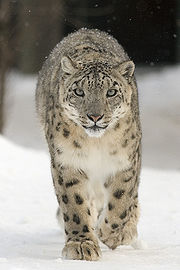Animals of Tibet's Chang Tang
The wildlife on the upper roof of the world.
Snow Leopard

The snow leopard (Uncia uncia or Panthera uncia), sometimes known as ounce, is a moderately large cat native to the mountain ranges of Central Asia. The classification of this species has been subject to change and its exact taxonomic position will not be resolved until further studies are conducted.
Snow leopards live between 3,000 and 5,500 metres (9,800 and 18,000 ft) above sea level in the rocky mountain ranges of Central Asia. However, their secretive nature means that their exact numbers are not known, although it has been estimated that between 3,500 and 7,000 snow leopards exist in the wild and between 600 and 700 in zoos worldwide.[3]
Snow leopards are smaller than the other big cats but like them, exhibit a range of sizes, generally weighing between 27 and 54 kilograms (60 and 120 lb). Body length ranges from 75 to 130 centimetres (30 to 50 in), with a tail of nearly the same length.[4]
Snow leopards have long thick fur, the base colour of which varies from smoky grey to yellowish tan, with whitish underparts. They have dark grey to black open rosettes on their body with small spots of the same colour on their heads and larger spots on their legs and tail.[4]
Snow leopards show several adaptations for living in a cold mountainous environment. Their bodies are stocky, their fur is thick, and their ears are small and rounded, all of which help to minimize heat loss. Their feet are wide, which distributes their weight better for walking on snow, and they have fur on their undersides to increase their traction on steep and unstable surfaces, as well as to assist with minimizing heat loss. Snow leopards' tails are long and flexible, helping them to maintain their balance. The tails are also very thickly covered with fur which, apart from minimizing heat loss, allows them to be used like a blanket to protect their faces when asleep.[4][5]
Snow leopards cannot roar, despite possessing some ossification of the hyoid bone. The presence of this ossification was previously thought to be essential for allowing the big cats to roar, but new studies show that the ability to roar is due to other morphological features, especially of the larynx, which are absent in the snow leopard.[6][7]
Additional info